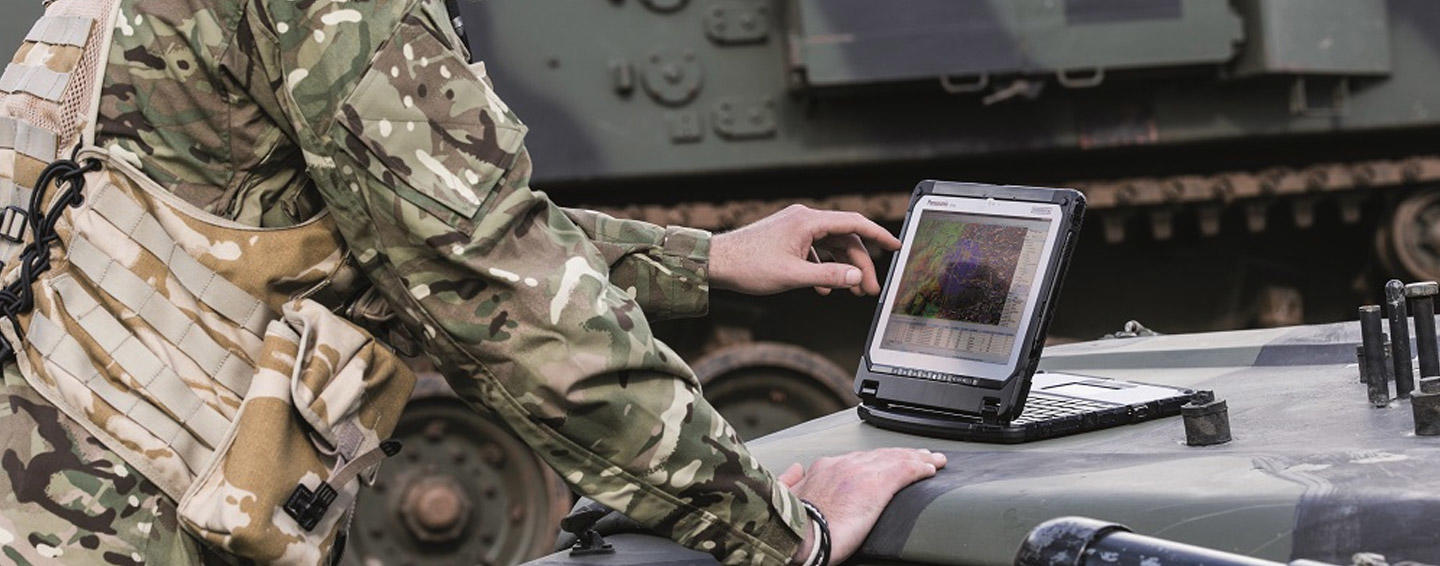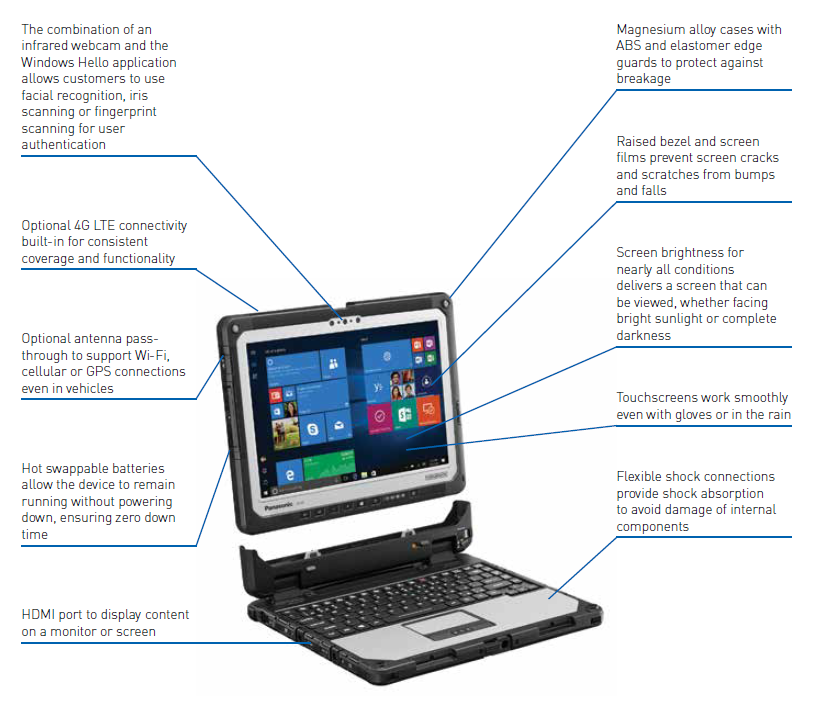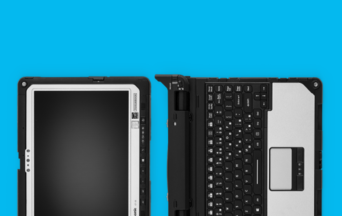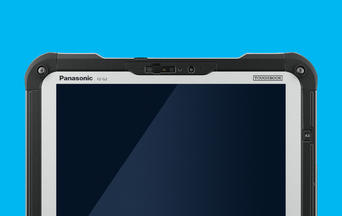Military laptops

Not all rugged is created equal
Everything you need to know about MIL-STD-810G certification and rugged device claims.
A Buyer’s Guide to Rugged Mobility
Understanding Mil-Spec testing is the first step in selecting the highest quality, most reliable rugged device for your needs. Customers who are armed with the key questions they should be asking are best positioned to understand the product they are investing in. When evaluating products, look beyond the spec sheet. Were the products merely designed to meet Mil-Spec or were they actually tested? Ask for third-party testing results to be 100% confident in the data. With no governing body conducting Mil-Spec testing, third-party validation is the only way to ensure rugged testing claims are true. It is important to ask for independent lab testing results and details on each specific test, the number of products used and what parameters were given and any modifications made during testing. Consider how the device will fit into your total mobility solution. Investing in rugged means that your devices need to keep up with the demanding environments of your workers and last for years to come. Here are the questions you should be asking:
- Were the right tests passed?
Potential buyers shouldn’t hear “Mil-Spec certified” and assume the device is rugged in all the potential testing categories. There are numerous types of tests, all done independently, so verify the device has passed the ones that best reflect the environment it will be deployed in. A manufacturer may claim to have a “Mil-Spec” ruggedized device, but when you read the fine print, you may see it was only tested for altitude and not drops or spills, the most common causes of failure. - What is the fine print?
Each supplier of rugged computing equipment is expected to assure or guarantee adherence to the standards and can set their own parameters for the testing. Always ask for third-party validation of the tests that were passed. Also, remember to ask for details—for drop tests, for example, ask how many devices it took to pass and from what height. While MIL-STD-810G allows up to five devices to be used, Panasonic typically only uses one unit during the testing for fully rugged models. - What is the annual failure rate?
In the end, reliability as seen in low failure rates, is what counts. After all, Mil-Spec is just a test. Whether a computer continues to operate smoothly after several years of hard use in extreme environments is the best determinant of how rugged it really is. Ask the manufacturer to share verifiable data on how their computers have actually held up under real-world conditions. - What features are included?
Make sure you select a mobile device that works the way your workers do. For example, first responders and service members spend a significant amount of time outdoors and need daylight-viewable screens, as well as devices that can function in rain, snow and other extreme weather conditions. Gloved touch capability and a sturdy handle—for minimizing the potential for drops while carrying the device—are valuable features to consider. - What warranty and support is provided?
Beyond device warranty, consider the support available during and after deployment. Find a provider that will provide assistance should problems arise and work with you to resolve any issues. Investing in a device that is easily compatible with other systems can save headaches during future technology integrations. - What security measures are put in place?
Security is important to all business but especially critical for government workers. When valuable data is on the line, invest in a solution that will protect mission-critical information. Ask about features like a fingerprint reader or a SmartCard reader. Additional security features to ask for might include the Opal standard for hardware-based disk encryption necessary for DoD applications and Intel security measures such as Intel® Trusted Platform Module (TPM) 2.0 and be sure to select a CPU with Intel® vPro™ Technology for added security and manageability capabilities such as threat management from viruses and malware, protection of confidential personal and business data and remote monitoring, remediation, and repair of PCs.
Rugged Tests – What Are They and Why Do They Matter?
Through a series of tests collectively known as MIL-STD-810G (Mil-Spec), manufacturers simulate how a mobile device will operate under a variety of extreme stressors and environmental conditions. These tests can be modified to fit the needs of a specific customer or industry, allowing manufacturers to choose the tests they want and then adjust parameters accordingly. The tests have been revised throughout the years (MIL-STD-810G Change 1 is the latest version) to reflect the ever-evolving needs of military personnel, and have become a common benchmark across the industry in validating whether or not a device can be considered “rugged.” MIL-STD- 810G covers a variety of scenarios like drops and vibrations, extreme temperatures, high altitudes, water resistance and dust intake. For a truly durable mobile device that will survive mission critical jobs, buyers should make sure a device has third-party validation of all Mil-Spec claims to ensure it will meet their performance needs.
| MIL-STD-810G Change 1 Test Name |
Description | Why it matters |
| Transit Drop Method 516.7 Procedure IV |
A device is dropped from various heights at 26 different angles onto 2-inch thick plywood over steel plate on concrete, and the height at which the unit will still turn on and operate is the rated drop specification. | Drops are one of the most common causes of damage to business mobile devices and given their often nontraditional working environments, mobile workers are even more likely to drop their devices during the course of their day. |
| Altitude Method 500.6 Procedure I & II |
A performance test is conducted on a device in an altitude chamber simulating 15,000 feet or more above sea level to test the performance of materials and systems under low pressure conditions under non-operating and operating conditions. | With the reduced atmosphere at 15,000 feet, it is much easier for vibrations to cause an impact between the needle and the platter. Workers collecting valuable data for mission-critical decisions in high altitude locations can't easily replace a failed device. |
| Blowing Rain Method 506.6 Procedure I |
A device is blasted with 5.8 inches-per-hour or more rain and 70 mph winds, for 30 minutes per surface while remaining operational. | Few mission-critical workers can put their work on hold due to a rainstorm. This test simulates using the device in inclement weather or on a job site around water. |
| High Temperature Method 501.6 Procedure I & II |
An operational test of the device is performed at 60°C for thirty minutes and non-operational at 70°C for 7 days. | Mobile works need to trust that devices have the ability to survive and operate at extreme temperatures, whether it be hot or cold. On a 33°C day, temperatures in a vehicle can reach 48°C in less than 40 minutes. |
| Vibration Method 514.7 Procedure I & II |
This test simulates the vibrations typically experienced in-flight or in an off road vehicle. | Whether used in patrol cars, tanks, ambulances or helicopters, mobile devices need to reliably function in heavy vibration environments. |
| Low Temperature Method 502.6 Procedure 1 & II |
A device is placed in a -28°C environment for thirty minutes in the extreme cold while the unit is on and -51°C when the unit is off. | This test validates that a device will operate at extreme winter conditions, without damaging the hard drive or experiencing data migration in an SSD. |
| Temperature Shock Method 503.6 Procedure I |
A device goes through three cycles of testing where it is placed in an environment of 93°C then -53°C to test reliability when moving between extreme temperatures. | Devices will rotate through one temperature extreme to another, to demonstrate screen readability and internal electronics will stay intact through thermal shock. |
| Sand and Dust Method 510.6 Procedure I & II |
Dust and sand are blown at a device over several hours in an environment of 60°C. | This test simulates situations like desert sandstorms or dusty environments where unsealed devices may have internal components exposed and damaged due to contaminants. |
| Humidity Method 507.6 Procedure I & II |
For Procedure I, a device is tested in 15 days cycle between 91°C at 80% relative humidity and 71°C at 14% relative humidity. For Procedure II, a device is tested in temperature cycles of 30°C to 60°C at 95% relative humidity. | This test simulates how a unit might work outdoors in a humid environment or in many plant locations, demonstrating the ability to adapt to an extreme weather environment. |
| Explosive Atmosphere Method 511.6 Procedure I |
A device is placed in a sealed chamber with an explosive environment utilizing hexane in dry air. While in the chamber, the device is under pressure ranging from 1.50 PSIA to 14.30 PSIA at a temperature of approximately 60°C. | In extreme field work in environments with explosive gases, this test validates the device will not cause ignition for the safety of those in the area. |
Toughbook Testing Rigor
At Panasonic, we are dedicated to ensuring our devices uphold the promise of rugged reliability in a wide variety of environments. To do this, all of our devices, regardless of rugged class, must endure rigorous testing done by the Panasonic R&D engineers as well as at independent, internationally recognized third party test labs for our semi and fully rugged devices. Panasonic technicians perform these tests under parameters that often exceed the test specifications of MIL-STD 810G. Panasonic does this as part of our mission to deliver ever greater levels of functionality, performance and reliability.
Each year, over 1,000 Toughbook devices are tested in order to reveal and amend any weaknesses before they arrive in a customer’s hands. A primary goal of these testing procedures is to confirm that Toughbook devices not only meet, but exceed the MIL-STD-810G requirements, delivering an even higher degree of rugged certification. For example, the MIL-STD-810G Method 500 altitude test suggests testing in a chamber that simulates an altitude 15,000 feet above sea level. However, for our recent rugged products such as the Toughbook 20 and 33, we tested at 50,000 feet to validate the performance of the material and systems under extreme low pressure conditions.
Over 500 Checks and Tests
Toughbook Aces the Rugged Test
For over twenty years, Panasonic Toughbook computers have raised the bar for rugged mobile technology. From product design to testing and even delivery, Panasonic controls every aspect of the manufacturing process to ensure that our devices hold up to the rugged standards our customers expect, even after a sale is made.
Let’s take a look at the key Toughbook features that define our rugged promise:*
- Wide variety of products to choose from with Windows and Android operating systems
- Host of rugged, business-ready options extend functionality in the field to meet customer needs across markets
- Whether in cars, trucks, forklifts, rail cars or even boats, there are vehicle docks with installation kits and services available for quick and secure integration
- Optional SmartCard readers provide quick and secure log-ins
- Optional Barcode readers can be used for inventory purposes and other applications
- Optional Magstripe reader provides reliable ID and credit card authentication.
* The above product features may not be available on all product models.
With Panasonic, You Get More than Just a Mobile Device
Working in the most unforgiving environments, even the toughest devices need a helping hand. The Panasonic ProServices team can provide cradle-to-grave support in the form of planning, deployment, security and repair and replacement services. Any member of your organization who is impacted by mobile computers can benefit from these services, be it the IT department, finance staff or mobile workers in the field. With the help of our Panasonic ProServices, Toughbook customers have experienced benefits such as quicker deployment times, greater availability of IT resources, reduced ownership costs and increased productivity.
We recognize that company-wide deployment of new mobile devices is no easy feat, so our experienced engineers are available to provide a full system assessment, ride-alongs, software testing and IT training to nix any potential issues before deployment is even complete. As no one job is the same, the Panasonic National Service Center helps ensure each Toughbook device takes shape to your company’s specifications and needs. For nearly 30 years, our service center has performed stress testing, software imaging and integration of third party accessories to be confident that devices arrive field-ready and customized for your environment and the demanding work your team does.
Today’s world can be a tough place to work. That’s why our technicians and engineers know Panasonic products from the inside out and are available for on-site visits to adjust and optimize your Toughbook solution.






